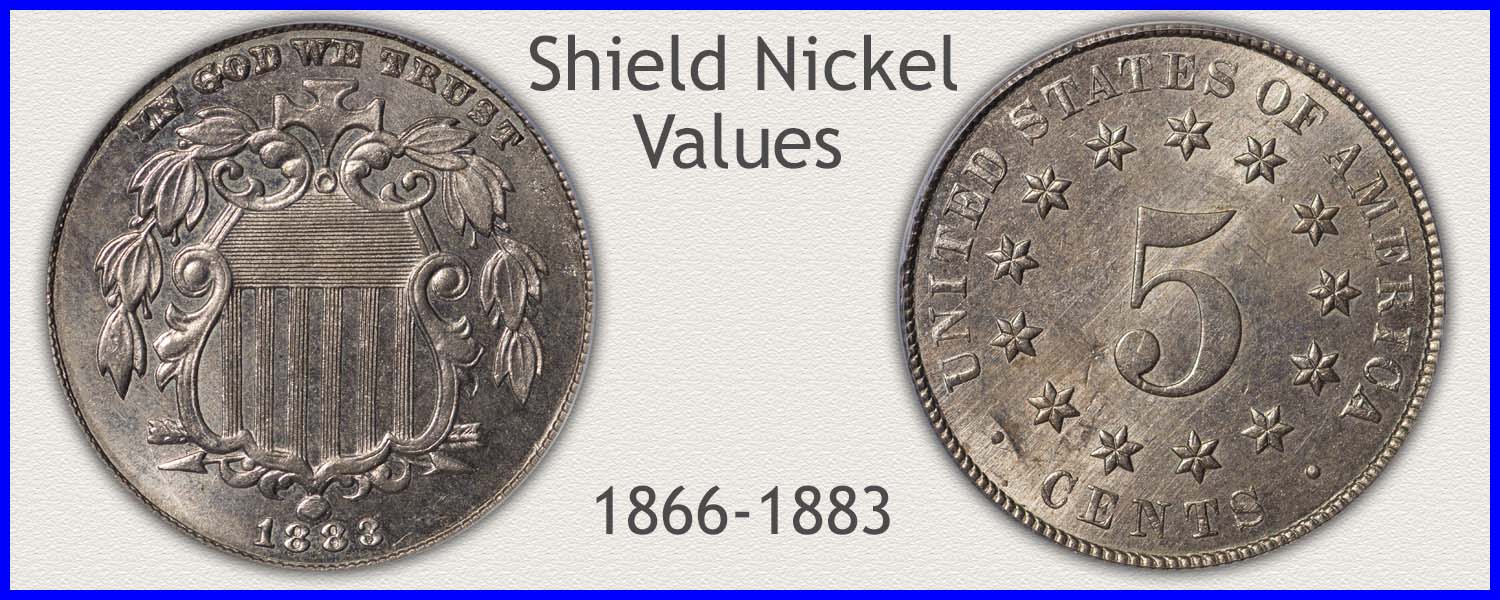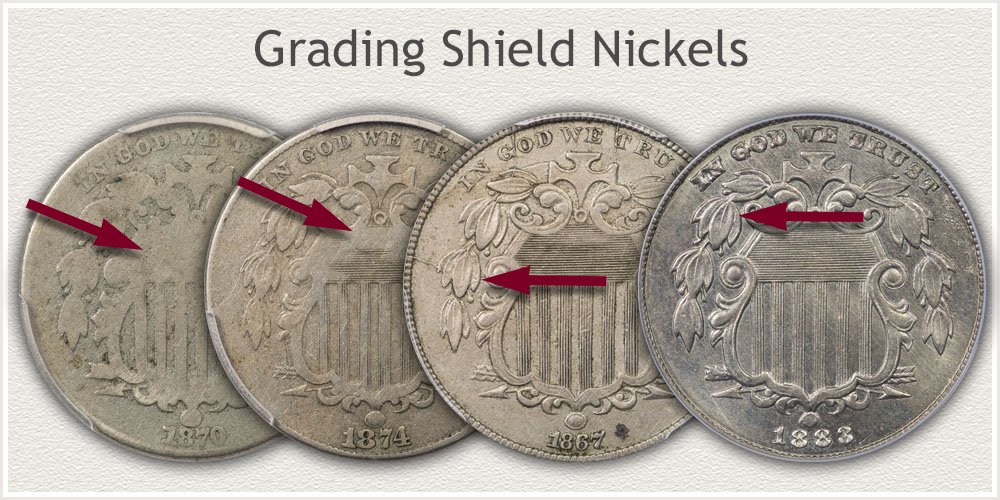Coin Values Moving with Precious Metals: Up-Dated 12/8/2025: Gold $4212 | Silver $58.12
1872 Nickel Value
One of the significant factors of Shield nickels is the scarcity of quality pieces. This, plus continued demand, supports a strong 1872 nickel value. In all levels of condition, the coin market places a nice premium on eye appealing examples.
As you examine these old nickels, follow the step-by-step process outlined below. A special attention to the date, and a judgment of condition complete most of the required facts. Next, inspect for additional special qualities. Many factors have the potential to enhance a coin's appeal and potential value.
Start with a review of the chart listing a range of how much an 1872 nickel is worth. Subtle features visible on the surface often improve its appeal to collectors.
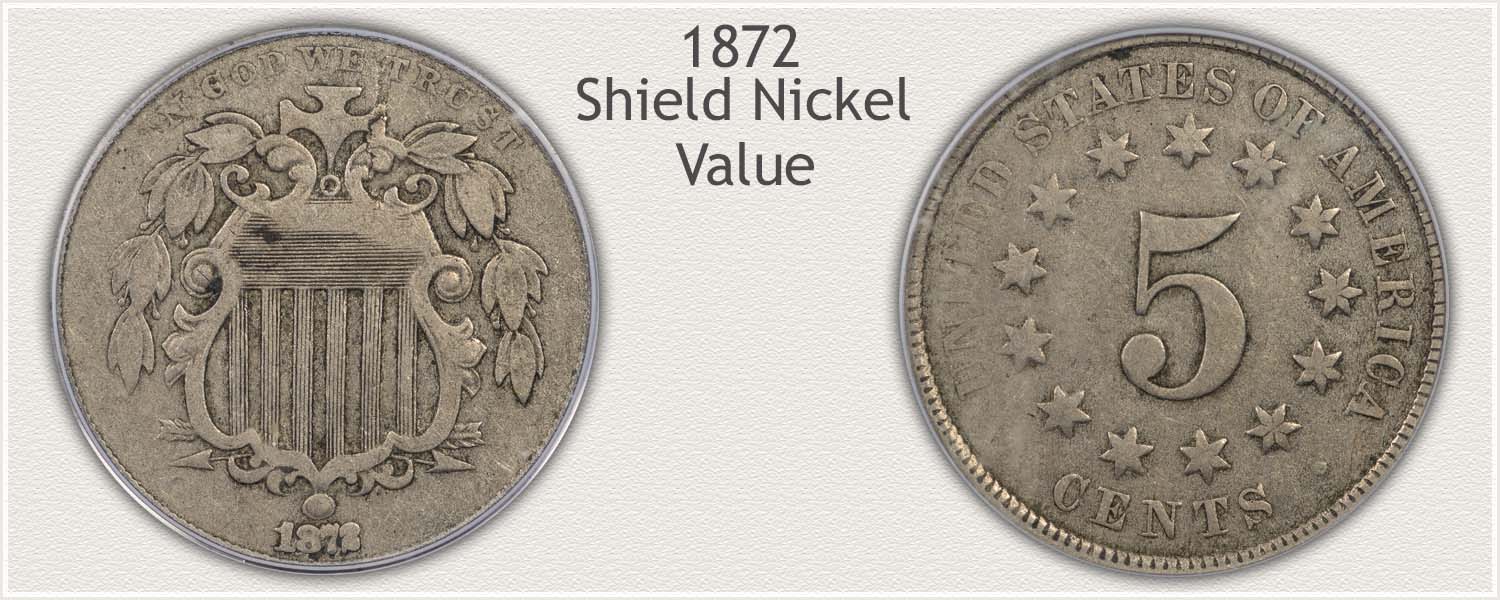
Steps Leading to Value:
- Step 1: Date Identified - A correct reading and recording of the date are required. This begins an accurate description of this collectible nickel in the Shield series.
- Step 2: Grading Condition - Note a wide range in premiums depending on a coin's condition. Judging quality by matching your coin to images narrows this range.
- Step 3: Special Qualities - An above average coin stands out when examined for subtle features.
| 1872 Nickel Value | ||||
|---|---|---|---|---|
| Condition of Coin | ||||
| Date | Good | Fine | Extremely Fine |
Mint State |
| 1872 Nickel Value Updated | 2025 | |||
| 1872 | $35 | $73 | $87 | $134 |
Wholesale value chart for 1872 nickels. Listing a range these nickels trade in the market. Note, small changes in condition and preservation result in changes in premiums.
Step 1: 1872 A Year of Rising Premiums
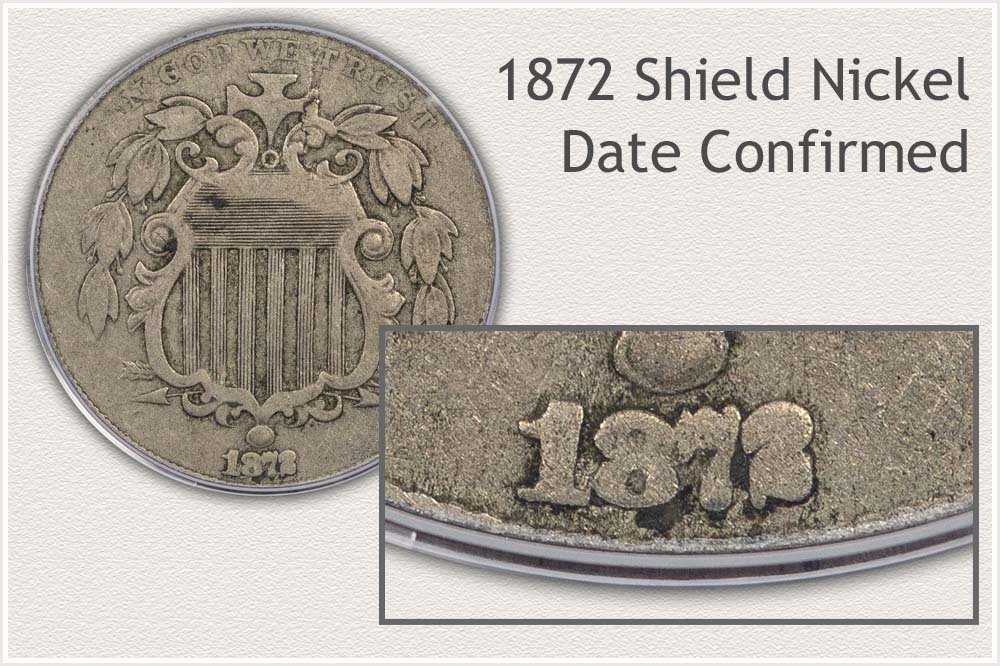
By 1872, it was six years after the introduction of a new nickel denomination. By now, the Philadelphia mint had a good idea of the yearly requirements for new production. The mint's first task was supplying enough nickels as they became a standard part of commerce. Then each year, replenish depleted supplies and produce enough to meet growing demand.
Quote from the 1872 U.S. Mint Annual Report
During the same period large orders were received for the bronze and copper-nickel coins, and the issue of the same on orders is constantly increasing. From present indications the issue of these coins will, in the future, exceed their redemption.
There were six million Shield nickels minted in 1872. Today these are developing an above average premium within the coin market. Most available today are in low condition. Finding a pleasing example represents a challenge for collectors. Coins with minimal wear are scarce. Confirming the date is the first step when deciding value. A small area just under the shield contains the date. Many times, because of its size, a magnifying glass verifies the exact date.
Step 2: | Examine a Coin's Appeal and Surface Preservation
An Uncommon Date Plus Quality Equals High 1872 Nickel Value
The amount of wear showing on a coin's surface determines its collectible level and scarcity. In the coin hobby, recognizable stages of wear are rated into different grades. At the top of the scale are Shield nickels without any wear. Mint State is the term used for this highest quality grade.
As wear removes metal, defined patterns develop across the surface. Identifying different levels of visible detail determines the extent of wear. Reference the images illustrating standard grades showing these wear amounts and details. As an example, a high condition nickel displays ample detail within the shield. Subtle differences separate both lower and higher condition and grade coins.
Compare coins to the images first to narrow a grade range. Descriptions focus on the key details needed to finalize judging the grade.
Mint State Grade
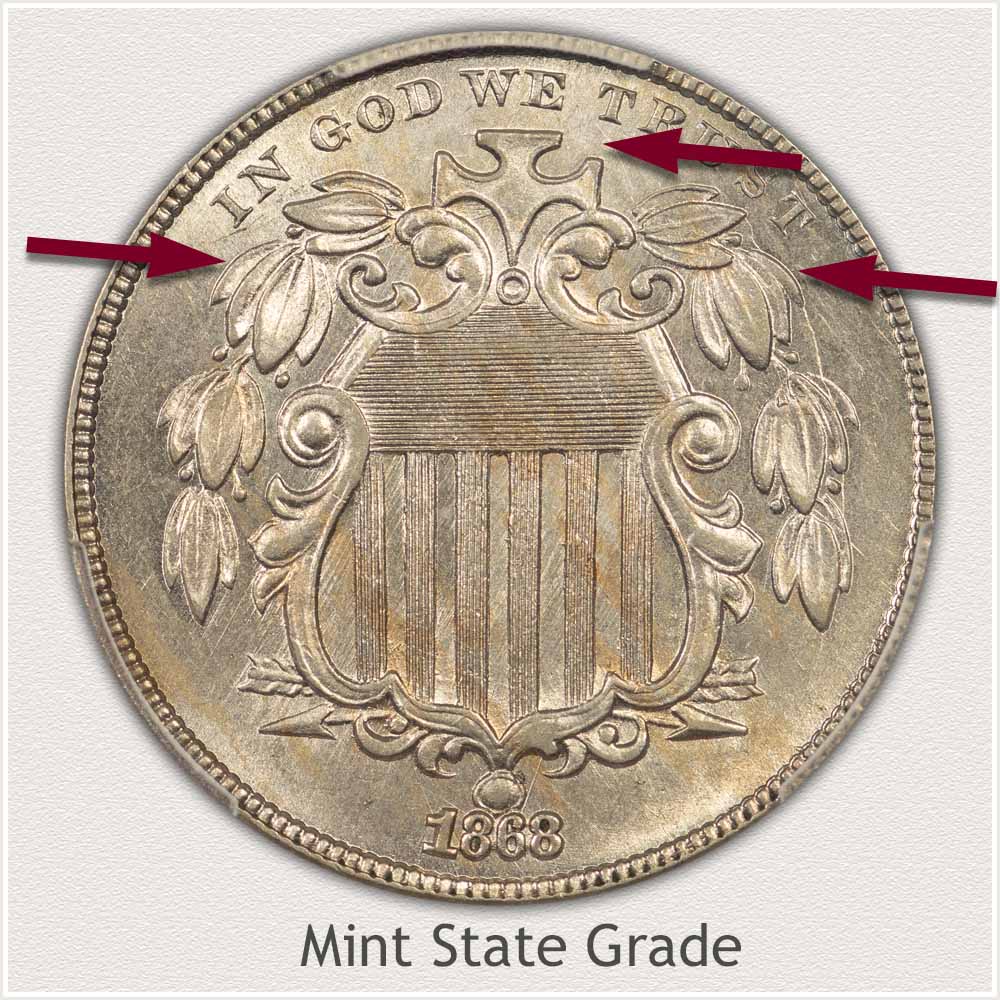
Mint State: Collectors and the coin market define a Mint State Shield nickel as a coin without any wear to its surface. Recognizing this condition "grades" the coin according to specific standards. No wear on the surface is the primary metric determining the grade. The intricate detail of these nickels provides key areas that show wear quickly and are easily seen.
Examine the Mint State example, specifically high points of the leaves on the left side. Their edges are raised above the inner area. Also, a raised vein runs through the center. Each of the high relief elements quickly flattens when worn. Raised and rounded leaf edges, without flatness, are a strong indication of a coin without wear. The vein within, when fully contoured, and with no flat spots, helps confirm the grade.
The cross at the top of the shield features both raised and recessed areas. Examine the fine line edge detail for signs of wear. Any wear to this surface flattens its roundness quickly. Worn metal appears smooth and displays a different shine from surrounding metal. Within the center of the cross, inspect the raised area for signs of smooth and flattened metal.
A subtle factor of Shield nickels is their original strike quality. The coin illustrated is nicely struck on its left side. Shield nickels are often well struck on one side and weak on the other. Use these left side design features as a guide. Helping to grade accurately, evaluate for any unbalance in strike quality. True wear is evenly distributed across a coin's surface.
Extremely Fine Grade
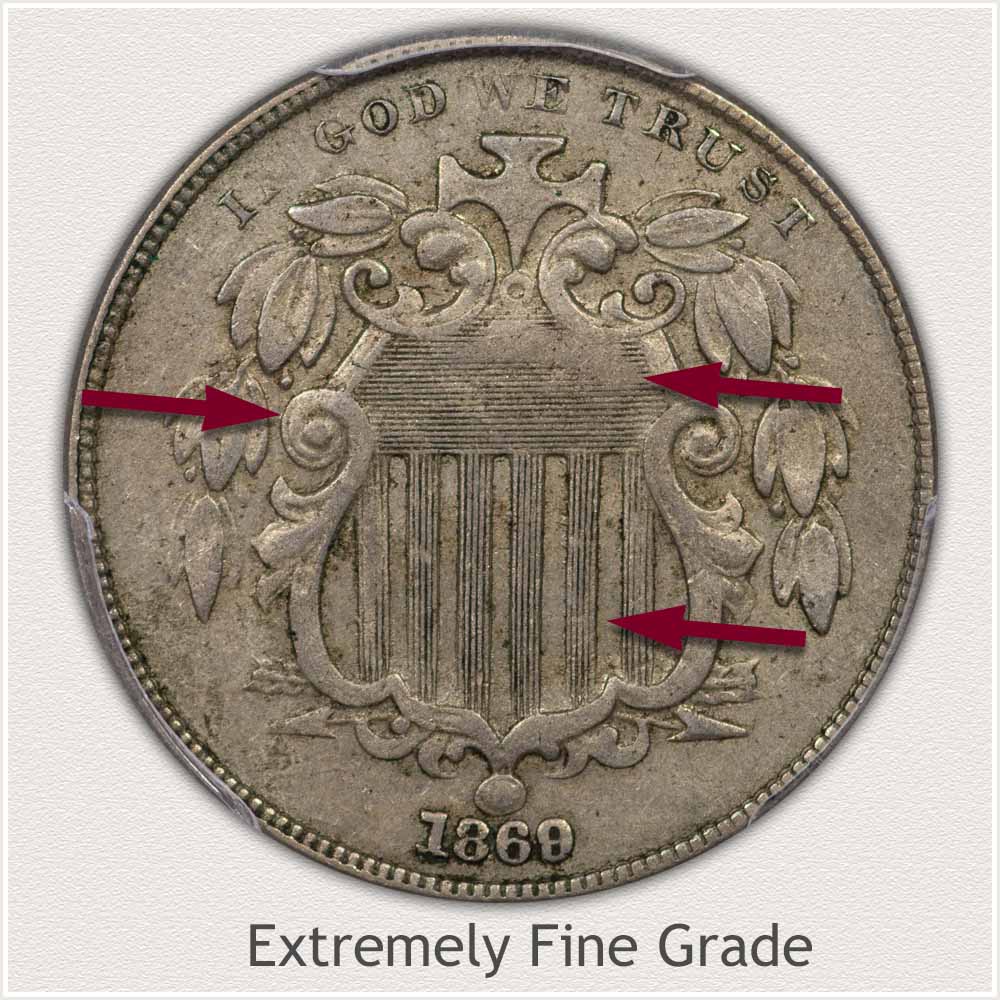
Extremely Fine: Typical of the Extremely Fine grade is light wear across the very top of high points. Viewing the high contours, the leaves and frame border show small, flat areas. Measure the amount of remaining detail to judge condition when deciding on a grade. First, examine the shield.
Within the shield itself, fine horizontal and vertical lines show wear, causing a few to merge. Missing line detail in the horizontal area typically shows in the upper part. Although well detailed, a small area of merged lines is within the grade range.
When compared to the horizontal lines, the vertical lines show far less merging. If there is any blending of lines, the areas are small and disconnected. Most lines, are very deeply separated and crisp. The example coin displays the required balance of slight wear with a slight merging of lines.
Next, examine the scroll elements bordering the interior of the shield. High contours and deep recesses form the intricate features of the border. Just under the cross at the top, wear flattens only the very high points of the rounded design. A deep recess remains, separating the curved features. The frame shows the greatest wear near the horizontal lines. Lower along the frame, fine detail emerges again, with high and low areas clearly defined. The frame either side of the vertical lines displays the required detail at this grade level.
Compare your coin with the example image. A strong match with central lines and details of the frame meets the grade standard. Extremely Fine grade Shield nickels present a crisp first impression.
Fine Grade
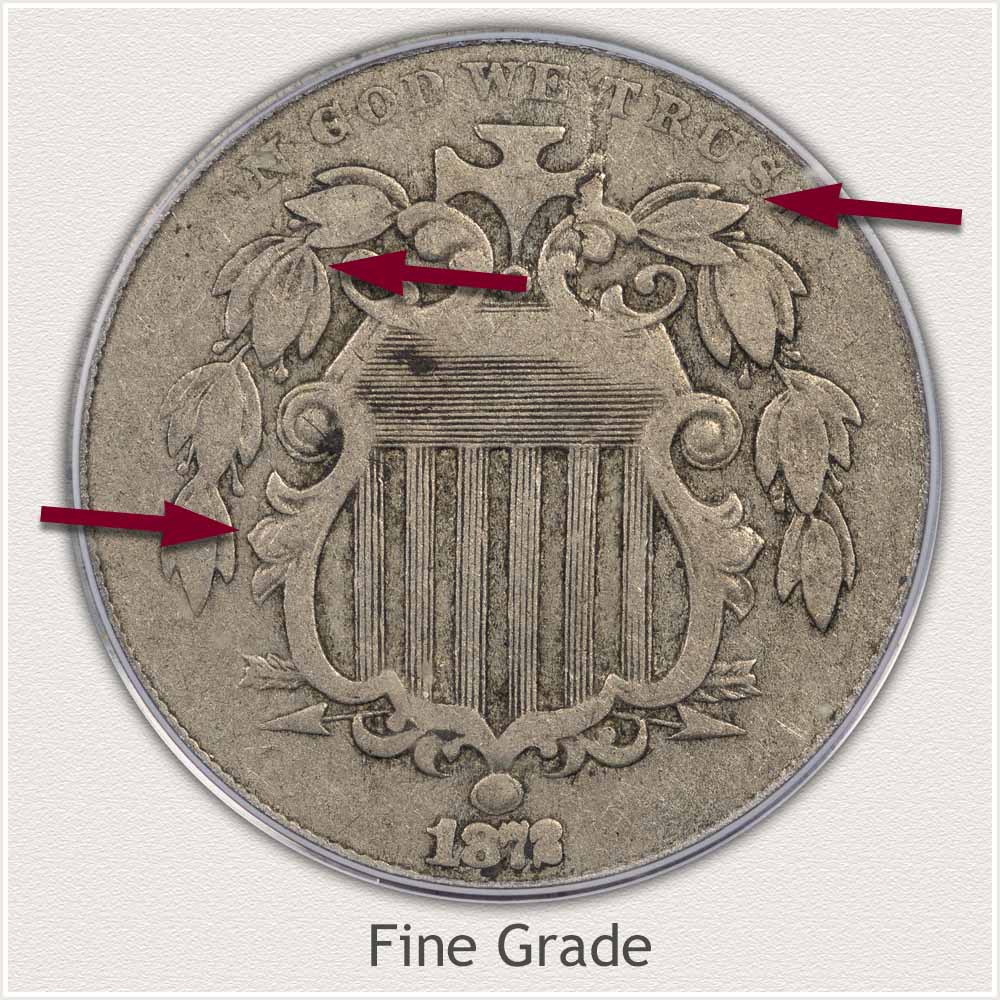
Fine Grade: Obvious wear now covers most features of a Shield nickel in Fine grade. Moderate wear without extensive merging of design elements defines the condition. Many areas of wear are offset by areas of intricate detail, giving a quality impression. A focus on two areas and their remaining details provides a good metric for measuring the amount of wear.
Olive branches with many leaf clusters hang on either side of the shield. Visible detail within the leaves serves to indicate wear levels. First, examine the illustrated Fine grade nickel. Note how wear completely flattens just a few leaves. Most leaves still display a raised inner vein. Wear concentrates at the tips and extends partly across the leaf. Strong edges to individual leaves and low relief areas remain. A close match of your coin to the example indicates meeting the Fine grade standard.
Inspect the decorative part of the shield border near the last leaf clusters. This border features curved and contoured areas separated by deep recesses. A slight amount of contour remains, with some fine line detail. It is the remaining contours of the frame indicating the grade level. Displaying a pleasing amount of detail is the overall look typical of a Fine grade nickel.
Good Grade
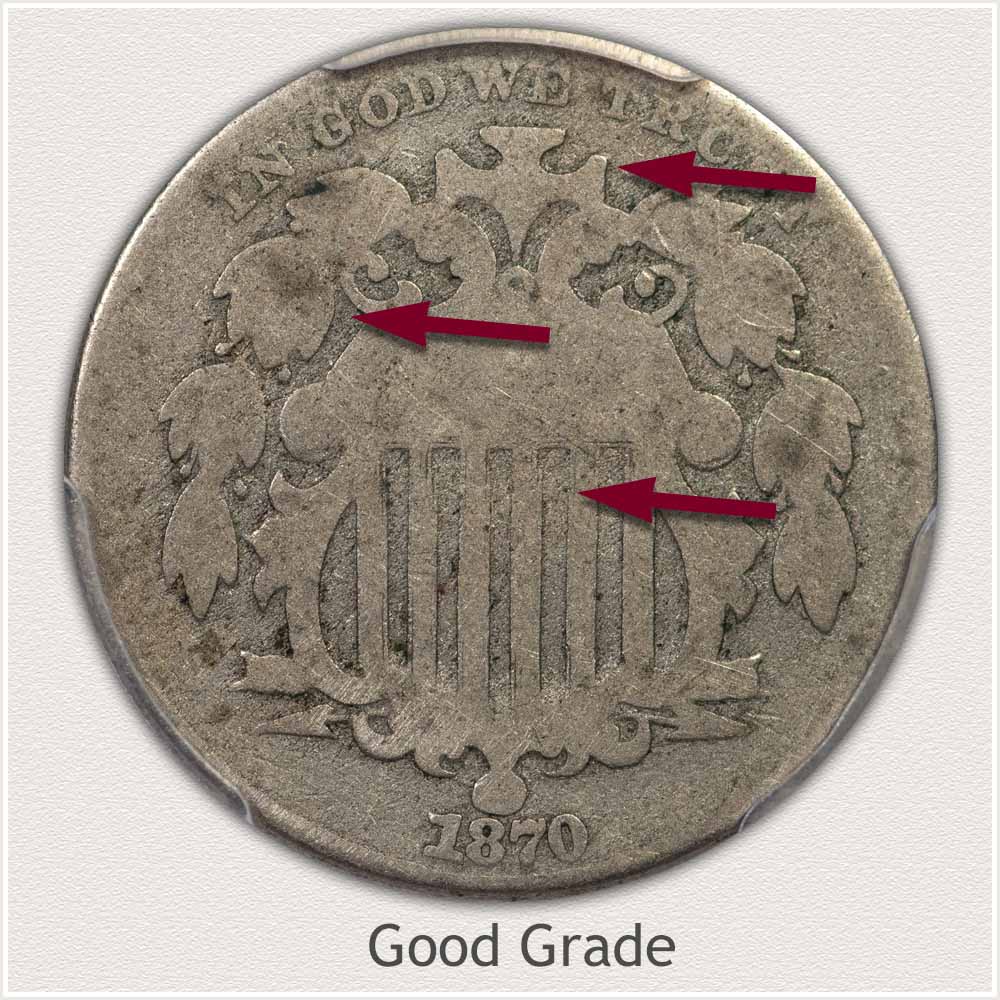
Good Grade: The example shows extensive wear; only major design features remain as outlines. This describes and defines a "Good" grade condition Shield nickel. In outline only, wear smooths the shield, leaves and cross. No central fine details show on these elements.
Separation of major features is an important metric required for the grade. Although the leaves of the wreath are flat, they do not merge with the inner shield or field of the coin. Distinct leaf groups are well outlined. Wear flattens the shield, but it remains separate of the leaves either side.
Within the center of the coin, strong vertical elements remain as stripes of the shield. Each is raised and complete. Notice a few fine lines in the stripes toward the bottom. This subtle detail confirms heavy wear but some elements are not completely missing.
A cross above the shield displays boldly. Its entire edge is complete, only merging where it meets the frame of the shield. High contoured features of a Good grade coin are now reduced to one level. What remains is bold, and the overall quality meets the grade standard.
How to Video: Grading Shield Nickels
Step 3: | Special Qualities | Recognizing the Subtle Surface Positives
Evaluate a Coin as a Collector
Identifying subtle qualities of these Shield nickels helps confirm high demand coins. An inspection, looking for specific features, separates coins with premium values and demand. Shield nickels are basically scarce, comparatively few of the entire series remain. This scarce nature includes the rare dates and any coin in above average condition.
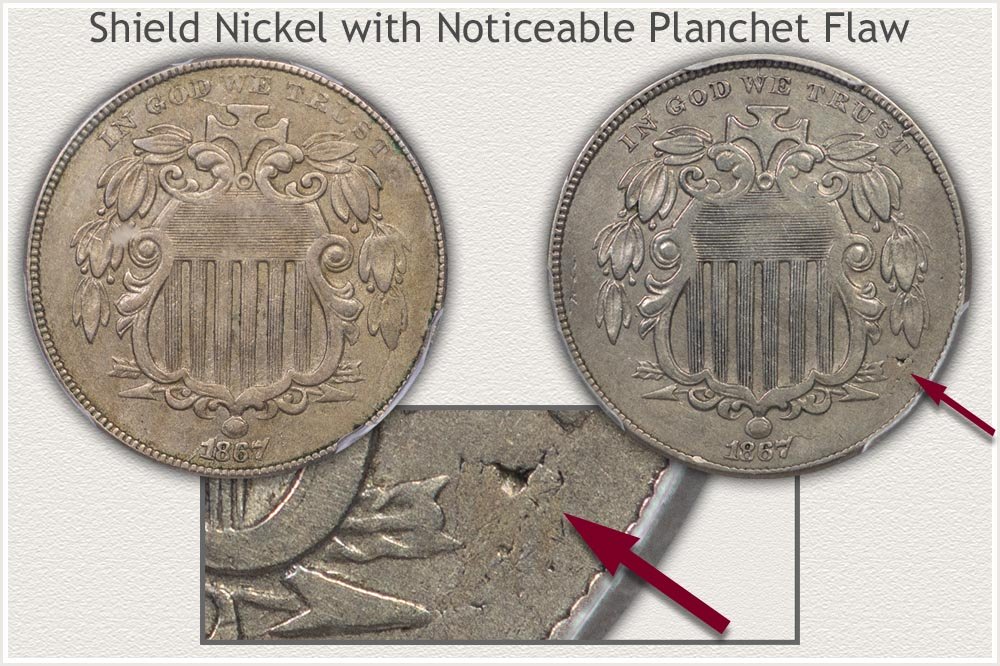 A Noticeable Planchet Flaw Lowers Appeal to Collectors
A Noticeable Planchet Flaw Lowers Appeal to Collectors
Many dates in the series are of high rarity. Additionally, nice condition coins are difficult to find. Any wholesome example, includes a subtle rarity factor.
Imaged are two lightly circulated condition nickels. Both, display a similar amount of wear. There is, however, a small feature separating the appeal between the coins. Scan the entire surface of the left-hand coin, its surface is very nice, nothing catches the eye.
When closely examined, the right-hand coin displays an imperfection near the lower edge. This roughness on the surface is a "planchet flaw." A planchet is the round, disk of a coin before it is struck. The planchet of this coin suffered from improper alloy mixing. Metal is missing from the brittle, fragile area. An unappealing flaw resulted on the surface. This roughness creates a subtle difference in both eye appeal and desirability.
Both the coin market and collectors value each coin differently. A strong preference is for coins without distractions, no matter how subtle. Without subtle flaws, Shield nickels become above average for their condition. This quality applies to all grades, from Good to Mint State.
References
U.S. Mint. Catalogue of Coins of the United States
https://nnp.wustl.edu/library/book/554591
U.S. Mint. 1888 U.S. Mint Annual Report
https://nnp.wustl.edu/library/book/313
U.S. Mint. 1872 U.S. Mint Annual Report
https://nnp.wustl.edu/library/book/309
Coin Values | CoinStudy Articles
Date by Date
In Depth Shield Nickel Value
Shield Nickel Value | Complete Value Chart of All Years
Complete listing of all Shield Nickel values. 1872 nickels are very scarce and are a value leader on the charts. Because of their age and historical significance, all dates are worth a close look. Separate your coins by condition. Look for above average examples to find a higher value.
How to Grade Shield Nickels | Visual Guide
Judging the condition of an 1872 Shield nickel determines a narrow condition range. Different grades are presented in the video, indicating features to examine. Subtle details are highlighted for specific requirements to meet the various grades. With images to illustrate important points, arrive at a conservative judgment of condition.
Print (Printable) the Coin Values Worksheet
Organize a list of your Shield Nickels, and all coins. Filling in the columns records key features needed to determine how much they are worth. Record factual details of the date and mint varieties. Next enter their condition and special qualities. With a full description, in one place, provides a written record.
Popular Coin Series | Potential of Shield Nickels
High premiums move towards the popular coin series collected. The different series of coins show in charts ranked in order of popularity. Gaining insight into demand and popularity, helps recognize scarce coins with solid value. Overall, the charts illustrate forming collections of nickels is moderately popular. Interest in Shield nickels is a series with high up-side potential.
Coin Value Guide | How to Value a Coin Collection
A step-by-step method combined with images works through how to value a coin collection. Sort and organize coins in a defined process. Identify each coin with accuracy, recording important details, and covering key features. Discover how much your box of old coins is worth.
★Coin Values Discovery finds 1872 Nickel Value and...
Old U.S. coin values. Use the step-by-step method outlined to evaluate and determine how much a box of old coins is worth. An emphasis on accuracy of the date, variety, and condition of the coin narrows its value range on the charts.
